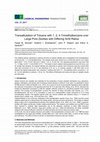Papers by Arthur Garforth
Chemical Engineering Journal, 2022

Microporous and Mesoporous Materials, 2021
Abstract The influence of the addition of 20–50 wt.% alumina binder on the physical, chemical and... more Abstract The influence of the addition of 20–50 wt.% alumina binder on the physical, chemical and catalytic properties and performance of zeolite Beta loaded with 0.08 wt.% Pt for the transalkylation of 1,2,4-trimethylbenzene (124-TMB) with toluene was studied. The catalytic tests were conducted in a fixed-bed reactor at WHSV of 5 h−1, 400 °C and 10 bar with a mixture of toluene and124-TMB feed in 50:50 wt. % ratio. The catalyst and binder mixture reduced the overall activity with increasing amount of binder. The progressive addition of the binder had a more negative effect on toluene conversion than 124-TMB which is explained by the increase in isomerization and disproportionation side reactions. The results suggested that Pt-Beta is responsible for the dealkylation reactions as the light products were decreased with increased binder contents. The xylenes yield was reduced upon addition of the binder from 39.5 to 30.5 wt. %. This can be explained by the increase of amount of coke formation per unit area of Pt-Beta over the catalysts and by the re-distribution of platinum particles.

This work details the generation of thin films of structured zeolite catalysts (ZSM–5 and Y) onto... more This work details the generation of thin films of structured zeolite catalysts (ZSM–5 and Y) onto the surface of a metal substrate (FeCrAlloy) using in-situ hydrothermal synthesis. In addition, the zeolite Y is post-synthetically modified by acidified ammonium ion exchange to generate US-Y. Finally the catalytic activity of the structured ZSM-5 catalyst films (Si/Al = 11, thickness 146 µm) and structured US–Y catalyst film (Si/Al = 8, thickness 23µm) were compared with the pelleted powder form of ZSM–5 and USY catalysts of similar Si/Al ratios. The structured catalyst films have been characterised using a range of techniques, including X-ray diffraction (XRD), Electron microscopy (SEM), Energy Dispersive X–ray analysis (EDX) and Thermogravimetric Analysis (TGA). The transition from oxide-on-alloy wires to hydrothermally synthesised uniformly zeolite coated surfaces was followed using SEM and XRD. In addition, the robustness of the prepared coating was confirmed by subjecting these t...

Applied Catalysis A: General, 2020
Abstract Effects of pore structure and acidity over Beta and Y zeolites with a range of Bronsted ... more Abstract Effects of pore structure and acidity over Beta and Y zeolites with a range of Bronsted and Lewis acid sites on their catalytic behaviour in the transalkylation reaction were investigated. The tests were conducted for a time-on-stream (TOS) of 50 h in a fixed-bed reactor at 400 °C, 10 bar, H2/HC = 4, and WHSV=5 h−1 with a 50:50 wt. % toluene:124-TMB mixture as feedstock. While initial (TOS ≤3 h) TMBs conversion was similar, wide differences were evident as the effects of partial deactivation became apparent with TOS. Zeolite Beta (Si/Al = 12.5) exhibited highest conversion and xylenes yield. As the Si/Al ratio of zeolite Beta is increased, the performance dropped whereas an opposite trend was observed for Y zeolites underscoring the importance of optimum level of dealumination depending on the zeolite structure. Isomerization of 124-TMB was observed over Beta which was not sustained by Y. The existence of separate active sites for TMB isomerization and its transalkylation with toluene in Beta is suggested.
Green Chemistry, 2020
Ionic liquids were shown to have a potential for simultaneous separation and recycling of plastic... more Ionic liquids were shown to have a potential for simultaneous separation and recycling of plastics from multicomponent waste streams.
ACS Sustainable Chemistry & Engineering, 2021
Chemical engineering transactions, 2015
Citation for published version (APA): Garforth, A., & Alnaimi, E. (2015). The Effect of Zeolite S... more Citation for published version (APA): Garforth, A., & Alnaimi, E. (2015). The Effect of Zeolite Structure and Acidity on Maximizing Propylene Production from an FCC Unit. In S. P. Pierucci, & J. J. Klemeš (Eds.), 12th International Conference on Chemical and Process Engineering (Vol. 43, pp. 859-864). (CHEMICAL ENGINEERING TRANSACTIONS VOL.43). CHEMICAL ENGINEERING TRANSACTIONS VOL.43: AIDIC. https://doi.org/DOI:10.3303/CET1543144

The catalytic activity, selectivity to xylenes and time-on-stream stability were investigated in ... more The catalytic activity, selectivity to xylenes and time-on-stream stability were investigated in the transalkylation of toluene with 1, 2, 4-trimethylbenzene. The catalytic tests were carried out in a fixed bed reactor over zeolite Beta (Si/Al = 12.5, 75 and 150) and Y (Si/Al = 2.6, 6, 15 and 30). The operating parameters used were 400 °C, 1.0 Mpa, H2/HC = 4 and WHSV of 5 h-1. The length of each catalytic testing experiment was 50 hours, and for zeolite beta samples, the highest stability and selectivity to xylenes were achieved using the lowest Si/Al ratio with conversion of 41 wt. % and selectivity of 61 wt. %. In contrast, zeolites Y with Si/Al ratio of 2.6 showed the highest deactivation rate, whereas Y zeolites with Si/Al = 6 – 30 exhibited similar conversion (~ 27 wt. %) and selectivity to xylenes (~ 43 wt. %). The effects of Bronsted and Lewis acid sites on catalytic results are discussed.
Feedstock recycling of waste plastics is becoming more crucial as a method to convert plastics ba... more Feedstock recycling of waste plastics is becoming more crucial as a method to convert plastics back into a source of useful platform chemicals. Although thermal cracking presents easier options, the products have limited utility and present a higher energy burden than the method proposed in this paper, that of catalytichydrocracking a mildly exothermic process. This paper reports the use of metal loaded zeolite catalysts at much reduced temperatures (200 �C - 350 �C) to convert mixed plastic waste at significantly shorter reaction times (typically 5 min), making the continuous processing of polymer waste a possibility.

FeCralloy rods (0.5 mm thickness) were subjected to high temperature thermal oxidation to produce... more FeCralloy rods (0.5 mm thickness) were subjected to high temperature thermal oxidation to produce a metastable alumina phase. This structured layer acts as an anchor to bind additional coatings of alumina via washcoat techniques, thereby improving the layer thickness and increasing adhesion of the catalytic surface. In addition, thin films of structured zeolite catalysts (ZSM-5 and Zeolite Y) were grown onto the surface of a metal substrate using in-situ hydrothermal synthesis. All catalysts were fully characterised by SEM, EDX and XRD. The cracking of n-heptane over structured catalysts for both ZSM-5 and Zeolite Y showed very similar product selectivity compared with similar traditional pelleted catalyst forms. The alumina coated FeCralloy rods were impregnated with 1 wt. % platinum and tested in a fixed bed reactor to assess the impact on yield for the dehydrogenation of methylcyclohexane and compared with conventional 1 wt. % Pt/Al2O3 pellets. This paper demonstrates that struct...

Microporous and Mesoporous Materials, 2021
Abstract With the growing concern around polymer waste sent to landfill and its environmental rel... more Abstract With the growing concern around polymer waste sent to landfill and its environmental release, one effective route for polymer recycling is hydrocracking over bifunctional zeolites. Zeolite Beta impregnated with 1% Pt has demonstrated high conversion of single and mixed streams of virgin and post-consumer polymers, LDPE, HDPE, PP and PS under mild reaction conditions of 330 °C, 20 bar H2 and a 30 min reaction time. The PE and PP streams giving a similar mix of low molecular weight hydrocarbons with higher selectivity toward gases (typically, C3–C4) and also, obtaining high iso-to normal paraffin ratio. PS was readily converted into an aromatic-rich product under these mild conditions and demonstrated the ability to be a source of benzene and ethylbenzene for use as raw materials in further polymer production. Dealuminated zeolite USY with 1% Pt increased the selectivity toward liquid products and resulting in more naphtha (C5–C12) and heavier liquids (C13–C20).
Applied Catalysis A: General, 2021
diminished only to Ringularly increase that of the inconsistent for a university to give the degr... more diminished only to Ringularly increase that of the inconsistent for a university to give the degree A.R. minor ones. Experience, nevertheless, seems to pro-(" artiulll baccalaureus") in its classical course and nounce rather in favor of the ascending method, which C. E. in its engineering course. In the second place, is applied with large chambers of feeble height at the the IIlultiplication of descriptive degrees leads to con Grand'Maison and with small chambers previously fURion. Shall the degree for a course in chemistry surrounded by a system of galleries at the Foret. be simply" chemist " (C.
Microporous and Mesoporous Materials, 2021
r a y u t e , H ol m e s, S t u a r t M., H a r d a c r e , C h ris t o p h er, G a rfo r t h, Ar... more r a y u t e , H ol m e s, S t u a r t M., H a r d a c r e , C h ris t o p h er, G a rfo r t h, Art h u r A., Yan g, Si h ai, Jiao, Yilai a n d F a n, Xiaol ei 2 0 2 1. An effici e n t m i c r o w av e-a s si s t e d c h el a tio n (MWAC) p o s t-sy n t h e tic m o dific a tio n m e t h o d t o p r o d u c e hi e r a r c hic al Y z e olit e s. Mi c r o p o r o u s a n d M e s o p o r o u s M a t e ri al s 3

Topics in Catalysis, 2020
A novel post-synthetic method combining the microwave (MW)-assisted dealumination and hydrotherma... more A novel post-synthetic method combining the microwave (MW)-assisted dealumination and hydrothermal (HT) alkaline treatment for obtaining mesoporous Y zeolite catalysts is presented. In the first-step MW-assisted dealumination of the pristine Y zeolite, both the mineral acid (i.e. hydrochloric acid, HCl) and organic carboxylic acids (e.g. oxalic and diethylenetriaminepentaacetic acid) were used (all at 0.16 M), and their effects on the physical and chemical properties of the resulting modified zeolites (after the identical HT alkaline treatment using 0.2 M sodium hydroxide solution) are studied in detail by comprehensive characterisation of the bulk silicon-to-aluminium (SAR) ratio, crystallinity and textural properties. The findings show that, in the developed sequential method, (i) HCl was only effective to achieve the hydrolysis of the zeolite, (ii) carboxylic acids with the function of chelation was very capable of extracting Al species and creating mesopores, and (iii) the mesopores formation is a function of the number of coordination sites in the carboxylic acid. The hierarchical feature of the mesopores in the modified zeolites (using carboxylic acids) was probed by the model reaction of aldol condensation of 1-heptanal with benzaldehyde for the selective formation of jasminaldehyde. The normalised selectivity to jasminaldehyde (with respect to the strong acidity) was proportionally related to the specific mesopores volume of the zeolites, revealing hierarchical porous networks in the relevant modified Y zeolites and indicating the effect of hierarchical mesopores in the zeolites on their catalytic performance.

Microporous and Mesoporous Materials, 2020
The effect of crystal size was explored in this work aiming at enhancing p-xylene selectivity thr... more The effect of crystal size was explored in this work aiming at enhancing p-xylene selectivity through toluene disproportionation over ZSM-5 zeolite. The different physicochemical properties of ZSM-5 were investigated using various characterization techniques including X-ray diffraction (XRD), pyridine adsorption, Fourier transform infra-red (FTIR), BET surface area by N2 adsorption, inductively coupled plasma (ICP) and scanning electron microscopy (SEM). Each catalyst was tested in a fixed bed reactor at a temperature 475 °C, weight hourly space velocity (WHSV) 3-83 h -1 and two different pressures (1 and 10 bar). ZSM-5 zeolites with crystal sizes 5, 50 and 100 µm were synthesized in house and compared with the commercially obtained ZSM-5 having a crystal size of 0.5 µm. As a result of increasing the crystal size the p-xylene selectivity was improved. This was attributed to the longer diffusion path lengths of the large crystals which imposed more diffusion constraints on the other xylene isomers. ZSM-5 zeolite with the largest crystal size 100 µm achieved the highest p-xylene selectivity (58 %) at the highest WHSV 83 h -1 . However, this was accompanied by a low conversion (2 wt. %). The best combination of p-xylene selectivity (40%) alongside 15 wt. % toluene conversion were achieved over ZSM-5 having 5 µm crystal sized.
Industrial & Engineering Chemistry Research, 2019
The hydrocracking of squalane and low density polyethylene (LDPE) into low molecular weight hydro... more The hydrocracking of squalane and low density polyethylene (LDPE) into low molecular weight hydrocarbons has been demonstrated with the use of bifunctional zeolite catalysts, Pt-impregnated USY and...

Industrial & Engineering Chemistry Research, 2017
Using industrially relevant operating parameters, the transalkylation of 1,2,4-Trimethylbenzene (... more Using industrially relevant operating parameters, the transalkylation of 1,2,4-Trimethylbenzene (TMB) with toluene was studied. The effect of acidity and structure, increased reaction pressure and very low levels of Pt impregnation have been investigated over both H-form and Pt-loaded zeolites: Beta, MOR, and Y. A fixed bed reactor was used at WHSV of 5 h -1 , 400 o C and a 50:50 wt. % Toluene:TMB ratio with the order of activity after 50 h TOS of Y > Beta >> MOR at 1 bar. At elevated pressure (10 bar), all catalysts showed better performance with significant improvement in MOR as pore blockage reduced and the order of activity was Beta > MOR > Y. Incorporation of Pt (0.08wt. %) further improved the activity of all catalysts with the highest conversion after 50 h TOS over Beta (62 wt. %) where Beta and MOR yielded similar levels of xylenes (40 wt. %). All catalysts were further optimized for activity whilst maintaining the desired stability and highest xylenes yield.
Structured metallic supports are currently found in catalytic converters for vehicles and similar... more Structured metallic supports are currently found in catalytic converters for vehicles and similar, with a trend being towards the use of these in packed bed reactors to replace the pelleted catalyst structure . Whilst the metal support offers exceptional heat transfer, the use of the system is currently limited due to surface adhesion issues. However, optimization of the wash-coat approach presents a possible solution to the issue, ensuring greater surface adhesion through the use of a platelet substructure formed by thermally oxidising FeCralloy rods [2 -4].










Uploads
Papers by Arthur Garforth